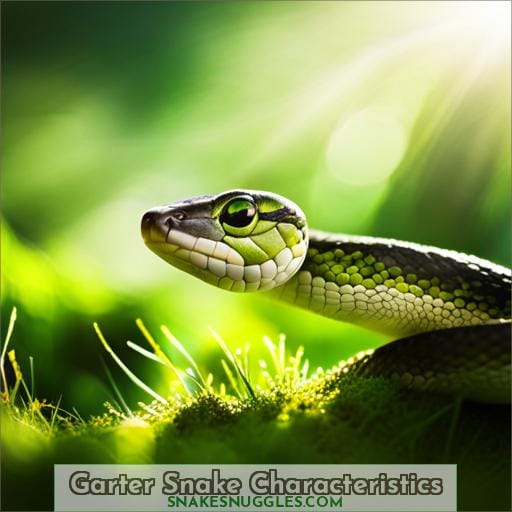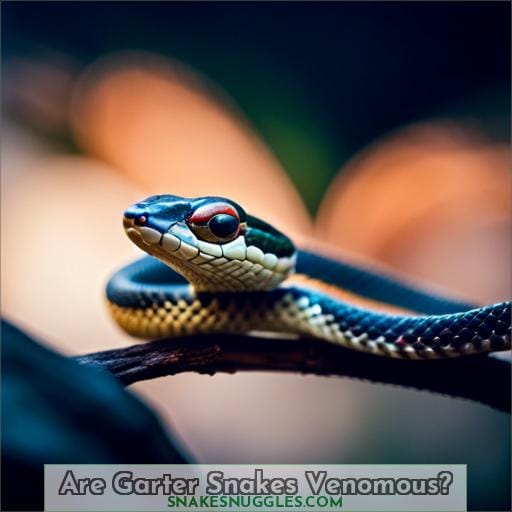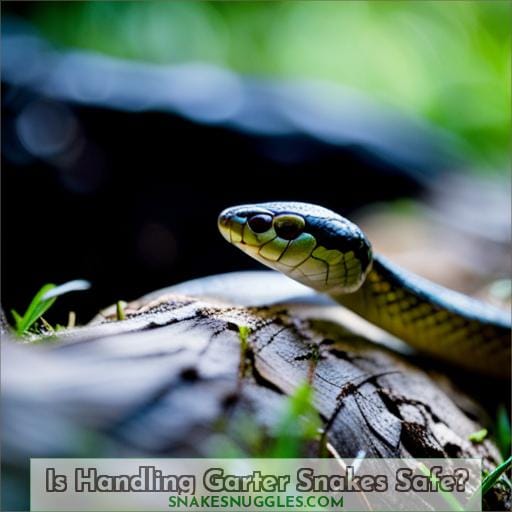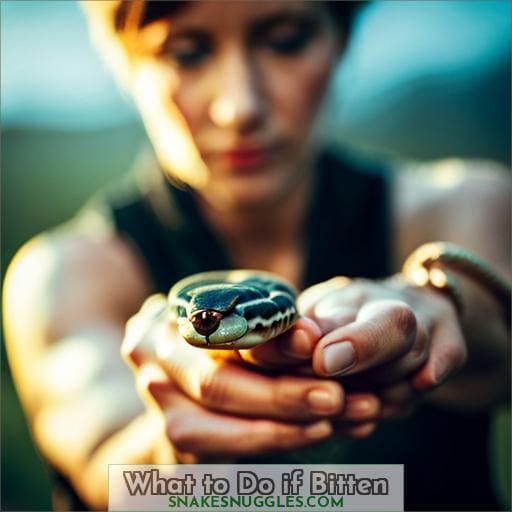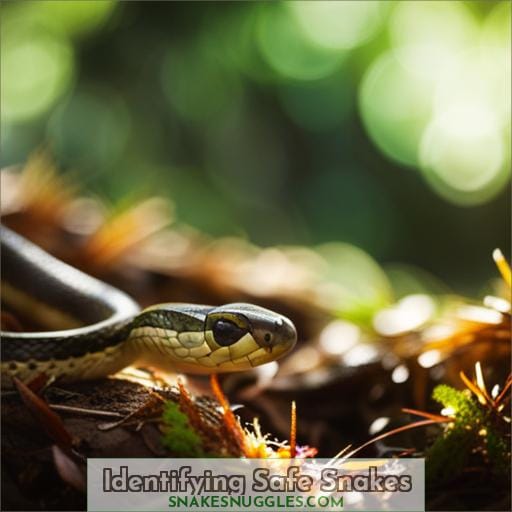This site is supported by our readers. We may earn a commission, at no cost to you, if you purchase through links.

These shy creatures crave safe shelter and pests to swallow, making your yard their trusty habitat.
Though they flaunt fangs, their bite brings no venom, so let them be; grant space for the helpful friend who gracefully gobbles up slugs and rodents roaming your rows.
Handle with care should you meet this harmless helper; be gentle if lifting for closer view, and quickly release to freely slither under leaves once more.
Table Of Contents
Key Takeaways
- Garter snakes have mild venom but are not dangerous to humans.
- Moving slowly and avoiding sudden movements can allow for safe handling.
- Picking up a garter snake properly behind the head prevents bites.
- Seek medical attention for any persisting infection from a bite.
Garter Snake Characteristics
When spotting a garter snake, first assess its appearance and behavior before reaching to pick it up.
Though harmless, these garden friends may bite if frightened, so move slowly and give them space.
With some quiet observation, you can safely enjoy their presence.
Appearance
One look at a garter snake with its three-striped pattern down its dark back, and you’ll know you’re seeing North America’s most common reptile in your garden.
Garter snakes exhibit color variations from yellow to blue, green, or brown. Their stripes also vary, with a narrow stripe running down the center of the back and a broader stripe on each side.
In size, garter snakes range between 18-26 inches as adults, but some can reach up to 4 feet.
When identifying garter snakes, note their signature striped appearance and nonthreatening presence in the garden.
Exercise caution with all wildlife while appreciating their role in our shared habitats.
Behavior
How do garter snakes typically behave when encountered in the garden?
You’re likely to see them slithering away quickly when startled, as they’re a shy, non-aggressive species that prefers retreating from humans if given the chance.
Nocturnal Activities:
- Emerging at dawn and dusk to hunt
Hiding Spots:
- Finding refuge under rocks, logs, and vegetation
Environmental Adaptations:
- Adjusting to various habitats and climates
- Consuming rodents, insects, frogs, fish, and eggs
Breeding Behavior:
- Courting in mating balls and bearing live young
Are Garter Snakes Venomous?
Despite their harmless nature, you’re often wondering if those garter snakes in your garden have venom that can harm you.
While garter snakes were previously thought to be non-venomous, recent research shows they produce a mild neurotoxic venom.
However, this venom isn’t dangerous to humans.
So when you encounter these beneficial snakes that feast on pests like slugs, cucumber beetles, and squash bugs, rest assured knowing they pose no harm.
Garter snakes help control nuisance rodents and insects that damage plants.
Their docile nature makes safe encounters in the garden likely, so long as you avoid picking them up.
While the garter snake myths portray a harmless snake, the neurotoxicity clarification confirms what many have believed all along – it’s safe to interact with these garden allies.
Is Handling Garter Snakes Safe?
You can safely handle these non-venomous snakes as long as you take proper precautions.
When interacting with garter snakes, move slowly and avoid making sudden movements that could startle them. Gently pick up the snake behind its head to avoid being bitten. Handle the snake over soft grass or a bed of leaves rather than over hard surfaces.
Educational programs teach proper handling techniques that minimize stress to the animal. Such wildlife encounters raise conservation awareness and inspire people to protect local species.
With some basic knowledge, garter snakes can provide a safe, educational hands-on experience, especially for children.
Always return the snake to its natural habitat once you finish observing it.
What to Do if Bitten
Although a garter snake’s bite is harmless, you should clean and disinfect the wound if one manages to nip you.
Even without venom, bacteria from the snake’s mouth can cause infection.
Use soap and water to wash the bite.
Then apply antiseptic to the area.
Cover with a clean bandage.
Monitor for signs of infection like redness, swelling, warmth, and pus.
Seek medical attention if these persist beyond 24 hours.
While extremely rare, be aware of potential allergic reaction.
Symptoms include breathing difficulty, hives, and swelling of throat and face.
Call emergency services if these develop.
Prevent future bites through awareness and caution.
Remain calm if you encounter a garter snake, and it will likely slither away.
Teach children to admire snakes from a distance and get help from an adult.
With proper precautions, we can safely appreciate these misunderstood backyard visitors.
Identifying Safe Snakes
Now that you know what to do if accidentally bitten while handling our slithery garden friends, let’s talk about identifying safe snakes to handle in the first place.
Learning safe approaches, species recognition, proper handling techniques, snake habitat awareness, and preventive measures will help ensure positive snake interactions.
When exploring the garden, scan surroundings before reaching to grasp so you don’t startle a venomous species.
Note snake characteristics like head shape and color patterning.
Nonvenomous snakes like garter snakes have slender heads and lengthwise stripes while venomous snakes often have triangular heads and blotchy bands.
Also, understand garter snakes typically occupy moist areas near water.
Equipping yourself with this knowledge means you can appreciate these beneficial pest controllers up close while still respecting them from a safe distance if they happen to be of the less cuddly variety.
Frequently Asked Questions (FAQs)
Can I keep a garter snake as a pet?
Yes, garter snakes can make good pets if properly cared for.
Obtain one from a reputable source.
Provide a spacious habitat with:
- Hiding spots
- Fresh water
- Warmth
- Proper lighting
Feed them a varied diet.
Be prepared for interactive handling as they’re active snakes.
With good husbandry, they can live 10+ years in captivity.
What do garter snakes eat in the wild?
Garter snakes eat a variety of small animals in the wild:
- Amphibians
- Earthworms
- Mice
- Fish
- Birds
- Other small snakes
- Slugs
- Snails
- Insects
- Spiders
They’re harmless and not aggressive, but shouldn’t be picked up.
How long do garter snakes live?
Garter snakes typically live between 2 to 8 years in the wild.
Their lifespan depends on factors like habitat, availability of prey, weather conditions, and ability to avoid predators.
Though harmless, it’s best you don’t pick up wild garter snakes unnecessarily, as this stresses them.
Simply observe them from a respectful distance.
Why do garter snakes vibrate their tails?
When startled, garter snakes may vibrate their tails as a defense mechanism to warn predators.
This harmless behavior signals they’re alarmed and may strike if further threatened, though their mild venom poses little danger to humans.
Best to leave wild garter snakes alone and not pick them up.
What time of year are baby garter snakes born?
Anytime between July and October,
you’ll see baby garter snakes emerge from their mothers.
Though their tiny size seems harmless,
resist the urge to pick them up.
Even juvenile snakes may bite if they feel threatened.
Simply observe and appreciate these new lives
from a safe distance.
Conclusion
As you would a slippery rope, gently grasp the docile garter snake should interaction tempt you; yet swiftly free our slithering friend to the soil, for its task continues: squashing slugs that spoil our garden’s joys.
Though non-venomous and usually harmless, caution remains key with all creatures unknown; identify any snake before handling to ensure no fangs with venom roam.

